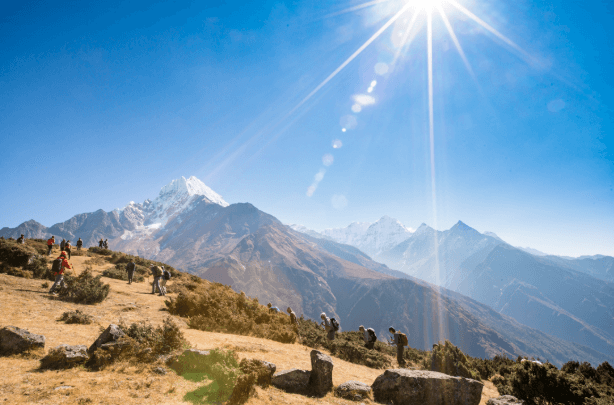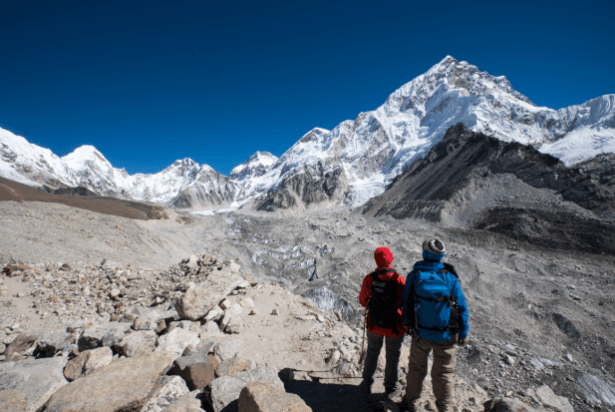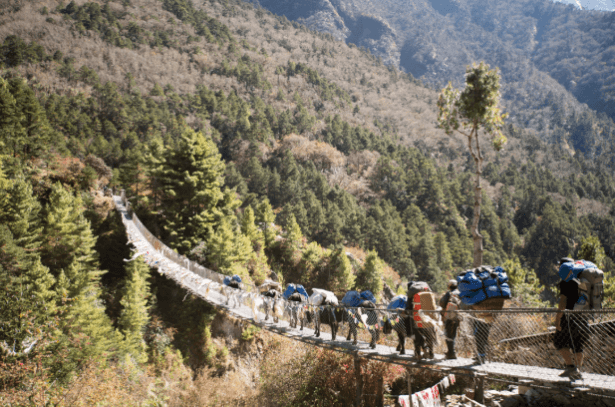Everest Base Camp (EBC) Trek is one of the most famous trekking routes in the world. Reaching the Everest Base Camp is a goal of thousands of trekking and adventure enthusiasts. I haven’t been yet, but of course Nepal and Tibet are on my whackpacking list of countries to visit.
Every year many people trek this glorious trail. The trail takes you through the lush valley, traditional villages and to the foothills of the world’s tallest mountain. Mount Everest Base Camp Trek will without a shadow of a doubt, give you an awesome experience.
Packing and planning for any trek is a delicate business. It can be a more daunting task when you are planning to go to the foothills of the highest mountain.
While the EBC trail is not the most difficult trek, one shouldn’t take it lightly. Proper preparation can ensure you have a better experience. Here are our 11 Everest Base Camp Tips to help you prepare for your trek.
1. Be Physically Prepared
The Everest Base Camp (EBC) Trek is a non-technical trek that requires no mountaineering experience. But again it’s vital you train ahead of your trip. Hiking a 130 km trail and climb Everest Base Camp at an altitude of 5,380 m will definitely take its toll on your body. Having a proper level of fitness will make your trek more enjoyable and easier.
A 15 km hike over a course of 6 hours a day might not seem like a big deal but the real challenge is that the EBC trail is mainly uphill and on rocky terrain. Moreover, you’ll need to be ready to hike comfortably the very next days. Hence, practice hike makes sense as you get used to the slow pace and rhythm of the trek.
To cope with the high altitude/low oxygen condition of the EBC Trek, you’ll need to have a good level of cardiovascular endurance. For this, we recommend you to jog uphill and undertake swimming, rowing or cycling activities. Another thing to focus on is strength training. You will need to focus more on your lower body.
Apart from this, it is essential to be mentally prepared as well. Your positive attitude will keep you moving during the trek.
2. Have the Right Gear
The weather up in the Everest Region can change dramatically as you ascend or descend. So, having the right gear will be crucial.
What clothing you pack will largely depend on the season in which you trek. The large variation in altitude and temperature during the trek makes layering a key concept. Being able to add or remove layers of clothing will allow you to remain comfortable and safe.
You’ll need a lightweight base layer clothing. On top of that, a fleece material for insulation. The outer layer should consist of a warm and waterproof jacket.
The same goes for trousers and pants. Trekking long hours in damp and soaked pants can be a nightmare. Hence, it’s crucial to have moisture-wicking mountaineering pants. These pants ensure proper insulation in your body as you trail the rugged EBC track.
Likewise, you will also need a proper hiking boot. Your boot should be of middle to lightweight and should offer good ankle support. We recommend you bring an extra trekking shoe and sandal to walk around tea-houses.
Even during the hottest time of the year, the temperature during the night will still be below zeroºC. So, a warm 4-season sleeping bag is a must. All the same, you should be well acquainted with temperature rating of backpacking sleeping bags. It is an indication of how well a bag can perform based on warmth. Depending on whether you are a hot sleeper or cold sleeper, it’s crucial you choose the right sleeping bag.
Along with that, you’ll need to bring other accessories like headwears, gloves, socks, trekking poles, sunglasses, etc.
You will need two sets of bags if your gears are to be carried by porters. A duffle bag to store all your gears and a daypack to carry your essential for the day.
Everything you need can be bought in Kathmandu. So don’t stress too much if you forgot something at home.
3. Bring Adequate Cash
Everest Base Camp trek takes you to one of the most remote regions in the world. Lukla and Namche Bazaar are the only two places along the trail where you can find ATM. On top of that their functionality is not guaranteed due to lack of proper maintenance, manpower, and power failure. So, it’s best to get cash exchanged in Kathmandu.
The amount of money you should take depends on your spending habits. The daily expenses you encounter are your accommodations, meals, snacks, and tips for guides and porters. On average, you’ll need $10-20 a day. It is better to have more just in case of some emergencies.
From charging your electronic devices to a liter of water, everything comes at a price. Moreover, everything becomes more expensive as you ascend higher. You’ll want to treat yourself after a long tiring walk. So, it’s important you take enough cash.
Kathmandu is the best place to exchange your money. You’ll get a better exchange rate here.
4. Have Proper Acclimatization
Altitude can be fatal. Countless people have needed to be helicoptered down or died from an altitude-related illness. Ignoring acclimatization one of many mistakes to avoid when trekking in Nepal. The trail to Everest Base Camp is easy however the trek is not. It is the altitude and climbing that makes the trek hard. As you ascend higher the air gets thinner, as a result, the level of oxygen decreases.
There are two kinds of altitude zones in the EBC trek: high altitude and very high altitude zone. The high altitude zone starts from 2500 m to 3500 m and from 3500 m to 5500 m is the very high altitude. Hence its crucial you take proper acclimatization days. Most of the itinerary consists of acclimatization at Namche Bazaar and Dingboche.
Altitude sickness is the number one reason trekkers don’t make it to the end. If you want to successfully trail the EBC trek, you need to watch out for it. Getting acclimated properly should be your top priority.
Altitude shouldn’t be taken lightly and getting higher faster can be disastrous. One of the most important tips you can get is to bring Diamox (altitude sickness coping medication).
5. Bring Water Purifier/Purification Tablets
Dehydration will exhaust you throughout the trek. So, keeping yourself hydrated is crucial. The human body gets dehydrated much quicker at a higher altitude. Staying hydrated reduces your chance of altitude sickness. Whilst, trekking the EBC trail you’ll need to intake 3-4 liters of fluids every day.
You can buy bottled water from tea houses along the trail. A liter of water at the start of the trek cost around $1 and as you go higher up it can cost a staggering $4. So, the best option is to bring along a water purifier or purification tablets. This not only reduces your expenses but also helps to keep the mountain clean. Purification tablets seem to be the best alternative. They are small, cheap and light to carry.
6. Bring A Camera
This is a no-brainer. You’re going to one of the most serene places on the planet. The view along the trail will blow your mind and you will want a way to capture it.
A simple shoot camera or even a smartphone can do the job. But if you really want to do justice to the Himalayas, a high-quality DSLR or a mirrorless camera is a must. You’ll want to take out your camera right after you land at Lukla.
An aerial snap of the Lukla Airport will let you know why it is one of the most dangerous airports in the world. Along the way, you’ll have endless moments to capture the beauty of Himalayas. You will not only want to click pictures to show to friends but to keep as a memory of your time.
Make sure to bring some extra batteries. You can charge them at tea houses but the places are very crowded. It’s advisable to keep your spare battery close to you as battery drain way faster in cold places.
Most importantly, you should know the ways to properly pack your camera gears inside the camera bag. Trekking uphill with your day’s pack plus a bulky camera bag can be strenuous. You need to think seriously about how and what you need to carry in your bag.
7. Take Care Of Your Feet
The EBC trek demands 5-6 hours of trekking over a course of 12-14 days. Your feet take the thrust of impact on trails. You will go only as far as your feet can take you. So, it’s important you be kind to your feet and take care of them.
Blisters and calluses can quickly turn your trek into a nightmare. It’s hard to enjoy the scenery and the mountains when you have a sore foot. A sore foot can end your trek just like altitude sickness.
It’s important you invest in a good pair of hiking boots. It’s the least your feet deserve after taking endless abuse. You should wear shoes you’ve had a chance to break-in. Clipping your toenails and lacing your boots properly is very important.
It’s crucial you protect those areas where you get frequent blisters. It’s best to start treating your feet as soon as you get the slightest sign of discomfort. Spending five to ten minutes treating them can save hours of painful hike.
Blister plasters are great and you should consider getting some. Apart from this, you must wash your feet thoroughly after every trek and inspect for any abrasion.
8. Pack A Map, Card Deck, And A book
While you spend most of your day’s trekking in the Everest region, you are still left with lots of spare time. You will get to your camp no later than 4 or 5 pm. This leaves a lot of time for activities and sometimes it can get a little boring.
Most of the tea houses have some kind of board games. Nonetheless, it’s good to have something to entertain yourself. A map can come in handy to check the altitude and prepare yourself for what to expect. It can be a good diversion from all the long walking and checking your progress.
Somedays, you may only have the energy to lay in bed and read a book. After a long strenuous walk, books can be a great escape. You should pack one or two books. You can buy them at Kathmandu or Namche Bazaar. You can also bring a card deck to enjoy with your fellow trekkers.
9. Bring Lots Of Snacks
All those long trekking will burn a lot of calories. On top of that, the altitude can make you not want to eat much. Nonetheless, it’s crucial you maintain your energy level to successfully complete the trek. It’s good to treat yourself every now and then to relieve some pressure.
While you can buy different kinds of snacks on the way, the price can demotivate you. So, we recommend you bring a few snacks. You can buy almost anything in Kathmandu. You can have some dry fruits, almonds or raisin in your daypack. These can be a good supplement of vitamins and minerals along the trail.
One or two Mars or Snicker bars a day are perfect for when you need a quick sugar injection. Stopping for a short break and taking a bite of a chocolate bar can be heavenly.
10. Make Way For Yaks And Sherpas
The EBC trek provides a great opportunity to interact with animals. Along the Everest region trail, you’ll come across mountain goats, beautiful birds, and robust yaks. All the supplies are carried up and down by donkey, yak or porters.
The arrival of yaks and animal is marked by a beautiful chime of bells. You should immediately find a safe place to stand on the mountainside and wait till they pass. You risk getting knocked off if you are on the wrong side. Most importantly, you should make way for the hard-working Sherpas and porters to make their lives a bit easier.
11. Relish The Journey
The most important thing to remember while you trek in the Everest region is that you enjoy every moment.
The Everest Base Camp trek is not only about reaching the base camp. There are endless highlights along the way. From a nerve-racking flight to Lukla, the mellow walk through Sagarmatha National Park to tying blessing scarf (Khada) on a suspension bridge, the EBC trek offers some beautiful memories.
On top of that, the beautiful town of Namche Bazaar, the mystical Tengboche Monastery, the simple-hard Sherpa life will melt your heart. To top that, walking in the shadow of the tallest peak will make you feel humble and submissive. Don’t forget, the panoramic view of Everest from Kala Patthar. Words fail to do justice.
Rather than focusing on the final destination, you should enjoy each and every moment the trail offers. Someone rightly said, “it’s not about the destination but the journey”.
Conclusion
Although it may seem nerve-racking, the EBC trek is doable. It will definitely exceed your expectations. You are sure to leave with your heart full of satisfaction and gratitude. It is a wonderful opportunity to interact with fellow trekker and the local Sherpa people, all the while taking in the breathtaking Himalayan scenery.
Our “11 Best Everest Camp Tips” covers some of the most important things to consider before you take the EBC trail. Once again you’ll need to be extra wary of the altitude. We hope you have a fruitful adventure.
Good luck and bon voyage!



